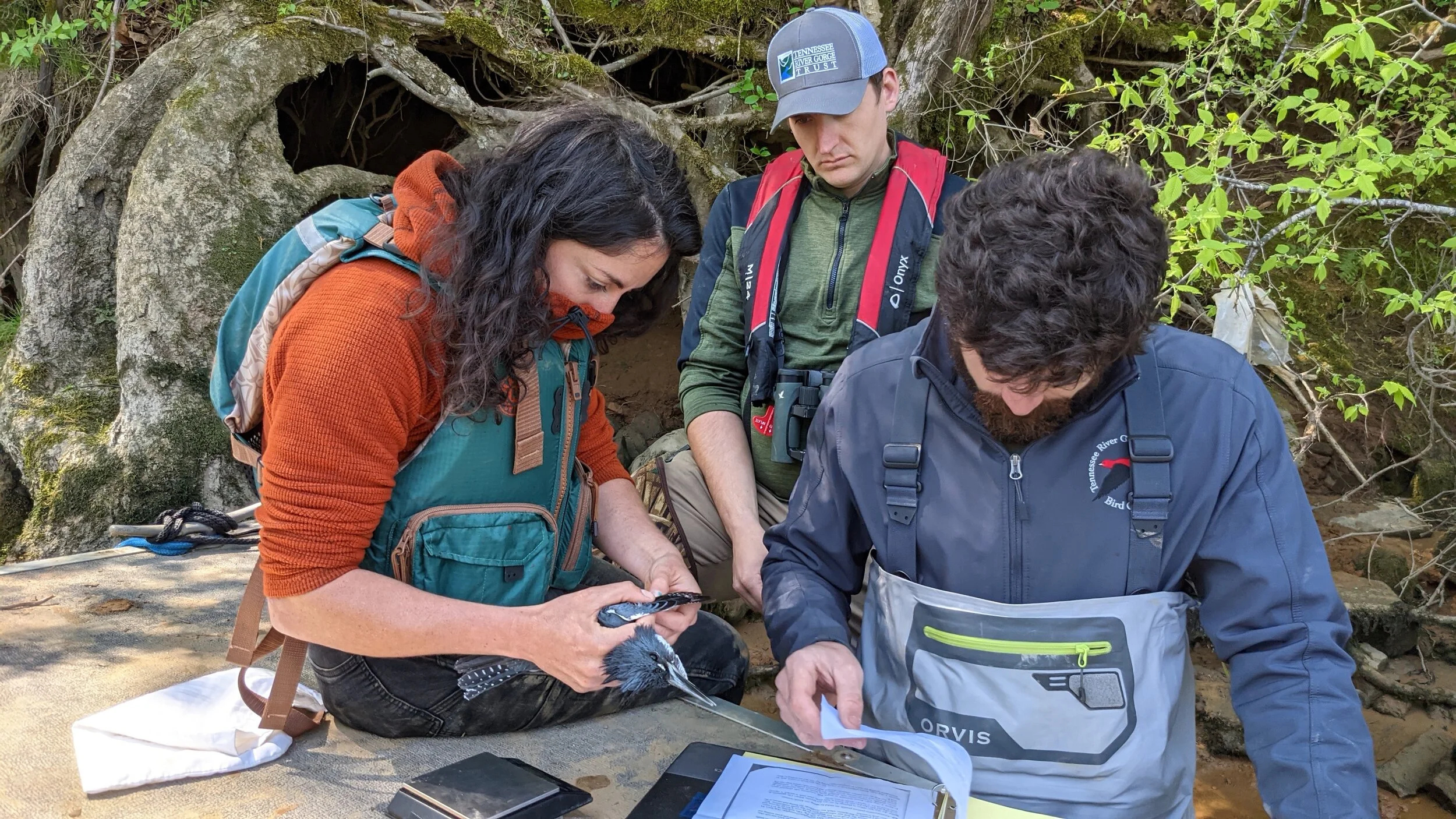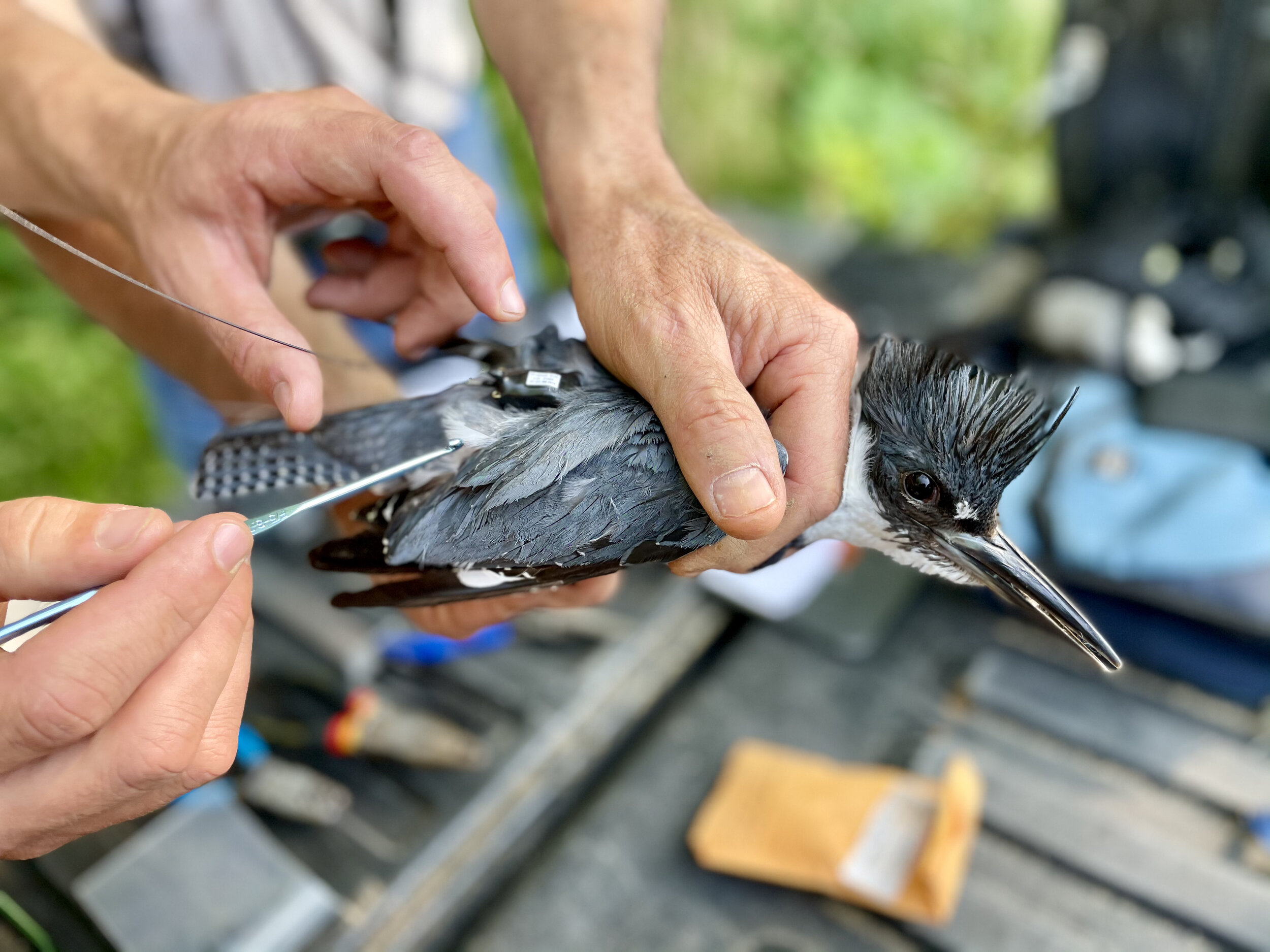The Mysterious World of the Belted Kingfisher
By Angie Langevin
As the TRGT conservation team continues to study the belted kingfisher, we continue to learn fascinating facts. This bird may be common, but because it is poorly understood by scientists, many of its mysteries remain unsolved. Read on to get the scoop on the wild and curious world of the belted kingfisher!
What’s in a Name?
Belted kingfishers get their common name from the band or “belt” that is present on their breast and on the female’s belly. Their scientific name is Megaceryle alcyon. The latin alcyon comes from the ancient Greek Ἀλκυόνη (Alkuone). In Greek mythology, Alycone was the daughter of the wind god Aeolus. Alcyone dove into the ocean in grief after her husband died in a shipwreck. The gods then took pity on the couple, turning them into a pair of kingfishers that continued to dive together into the oceans, rivers, and lakes of the world. Alcyone’s father Aeolus calmed the winds each year during their nesting period (the origin of the phrase “halcyon days”).
Fossilized Kingfishers
The oldest fossil recorded for a kingfisher is about 2 million years old! It was found in Alchua County, Florida in a limestone deposit where many other vertebrate fossils (including turtles, fish, opossums, alligators, and a giant ground-sloth) have been found. The deposit is thought to have been a large lake millions of years ago.
Bayous, Lakes, and Lagoons
Kingfishers may live and hunt in a variety of different aquatic habitats all over North America. They have been found along the coast, foraging off of docks, hanging out near ditches after heavy rains, perching over sandy river banks or sheltered coves. They may live near rivers, lakes, streams, bayous, mangroves, swamps, brackish lagoons, oxbows, offshore islands, and reservoirs.
Where’s BEKI?
You may hear TRGT researchers colloquially refer to the belted kingfisher as “Becky”. This nickname comes from the belted kingfisher’s four letter banding code: BEKI. Ornithologists across North America use these standardized four-letter codes as shorthand for quicker, more efficient data entry and communication. Want to sound extra nerdy at your next dinner party? Find out the scientific name and four-letter shorthand for your favorite backyard bird here.
What’s for Dinner?
Belted kingfishers love to eat many types of saltwater and freshwater fish: sticklebacks, trout, bluegill, minnows, and stonerollers are just a few of their favorites. Other kingfisher delicacies include crayfish, lizards, mollusks, insects, amphibians, small mammals, and even sometimes berries.
Digging Feet
Two of the toes of the Belted kingfisher are fused together. This is called a syndactyl foot. Their short, stocky legs and webbed toes make the kingfisher’s feet ideal for digging and slashing at the tall dirt banks where they build their nest cavity. They may dig a nest hole 1-4 meters deep into the earth!
The Mystery of the Female’s Belt
The female’s rusty “belt” is one of the many mysteries of the belted kingfisher. Female belted kingfishers have a rusty, cinnamon – colored belt that distinguishes them from males. The shape of each female’s auburn sash is unique. In bird species that have sexually dimorphic plumage, males usually appear more brightly colored than females. This is not the case for Belted Kingfishers, and scientists are still not sure why.
One possible explanation for this mystery is that the female’s belt is a signal to male kingfishers that she is indeed a female – and not a threat to their territory. However, some scientists think that kingfishers may be able to recognize each other by their loud rattling calls, which would debunk this hypothesis. Bright coloring in female birds often indicates a sexual “role reversal”. Colorful female phalaropes (a type of shorebird) are polyandrous, competing with other females to mate with multiple drab males. After the female lays her eggs, she leaves to mate with other males. The male finishes building the nest, incubates, feeds, and raises the young. Belted kingfishers also buck this “role reversal” hypothesis, with both sexes equally excavating a nest cavity, incubating eggs, feeding young, and defending a nesting territory once paired. Plumage dimorphism in belted kingfishers remains a conundrum, leaving many questions for curious researchers to try to untangle.
Family Matters
Belted kingfishers are in the Alcedinidae (Kingfisher) family. This family is full of many colorful relatives across every continent except Antarctica: the laughing kookaburra, the giant kingfisher, the malachite kingfisher, the African pygmy kingfisher, and the woodland kingfisher are just a handful of the many species in the family. The belted kingfisher’s next closest kin are the hoopoes, todies, rollers, bee-eaters, motmots, and hornbills of the order Coraciiformes.
Good Housekeeping
Many birds have adaptations that keep their nests clean while the nestlings are living there. Most baby birds will excrete a hygienic “poop sac” that encapsulates their waste until the parents take it out of the nest with their bills. Belted kingfishers nestlings however aren’t that tidy: they shoot their poop straight out onto the walls of the nest. They then help out with the chores by pecking and burying their poop into the wall of the nest. The nestlings essentially enlarge the nest as they grow by doing this over and over, saving the parents from having to keep digging to enlarge the nest!
A “Rattle” of Kingfishers
Belted kingfishers are known for their loud, dry, rattle call. They also use a high-pitched “scream” call as a greeting. When threatened, kingfishers may emit a loud rattle or they may attempt to intimidate the predator by screaming, spreading their wings, and raising their white eyespots




